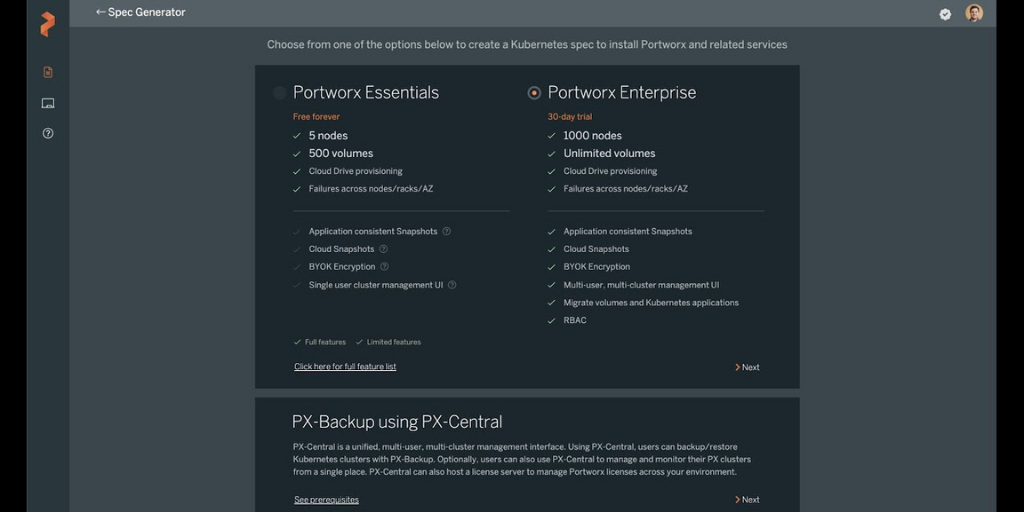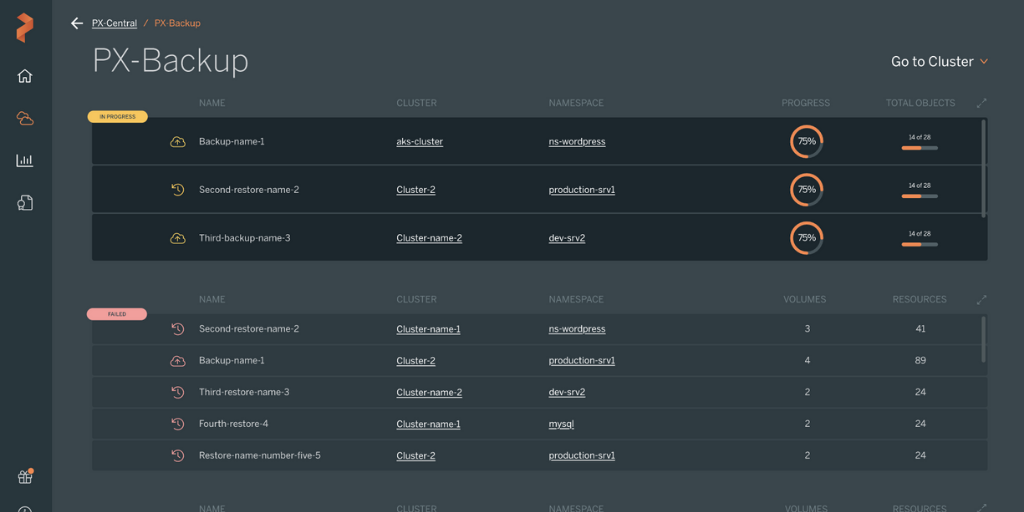Portworx Guided Hands On-Labs. Register Now
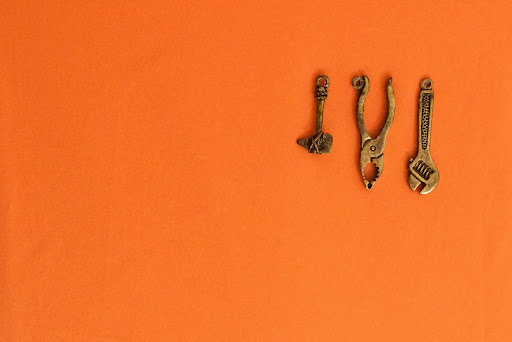
When it comes to backups, enterprises need more than one tool to fully reduce risk when they need to restore critical application data. Their backup and restore toolset should give them the flexibility to select the ideal tool to restore data for any environment—whether it is Kubernetes on cloud, hybrid, or on-prem. PX-Backup 2.1 introduces three major additions that give enterprises the ability to take advantage of in their Kubernetes deployments:
- Portability for backups with block and file volumes between clouds: This enables migration of any stateful application between on-prem, hybrid, and cloud Kubernetes environments, regardless of using Portworx Enterprise.
- Expanded recovery with support for file shares: In addition to existing capabilities to backup block-based workloads, enterprises can now backup and recover applications running on read-write-many (RWX) persistent volumes provisioned as file shares from FlashBlade, Portworx proxy volumes, or any NFS server.
- Improved compliance via 3-2-1 backup rule support: With this release, PX-Backup has added the capability to offload backups from CSI snapshots to object storage. Enterprises running Kubernetes applications on Portworx PX-Store, any CSI compliant storage service, or cloud-based storage can now use PX-Backup to maintain three copies of data (production, snapshots, backup copy) across both disk and object storage.
Nearly 55% of Kubernetes IT professionals say that backup and restore is a top concern for their stateful applications running on Kubernetes. Making sure your Kubernetes backup capabilities are scalable, flexible, and purpose-built for Kubernetes is important for your overall data protection plan.
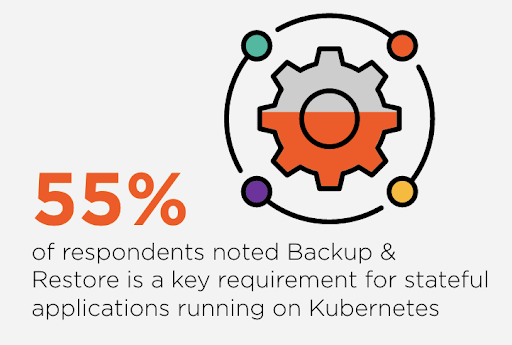
The Pure Storage Survey was conducted by Wakefield Research (www.wakefieldresearch.com) among 500 IT Professionals, employed full-time in the US (250) or UK (250) at companies of 500+ employees, who self-identify as possessing significant knowledge of their company’s Kubernetes usage and currently running stateful applications on Kubernetes.
Let’s dive into the PX-Backup 2.1 announcement a bit further.
Portability for Backups Between Clouds
Data protection is key for enterprises running Kubernetes. With this, making sure your applications are portable across Kubernetes environments can be just as critical. Offloading backups of stateful or stateless applications to cloud storage not only adds an extra layer of protection, but PX-Backup 2.1 now gives you the ability to restore across cloud and Kubernetes versions, whether they’re stateful or not.
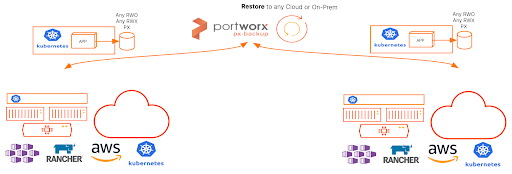
With PX-Backup 2.1, you can backup a non-Portworx volume—which can be ReadWriteMany or ReadWriteOnly—and restore it to any other cloud or Kubernetes environment, even if it doesn’t have the same type of store. Yes, this means you can restore into a Portworx volume from a non-Portworx source volume.
> Note: The source volume in this scenario is a StorageClass that supports CSI Snapshots.
To enable PX-Backup to take portable backups of your applications and their data, make sure PX-Backup is installed into your Kubernetes environment and is using version 2.1 or later. Next, add source Kubernetes clusters to your PX-Backup instance and configure cloud credentials.
PX-Backup 2.1 has backup intelligence built into its workflows, so a user doesn’t need to directly modify anything about their existing backup workflows in order for PX-Backup to make a portable backup from one backend to another. Simply choose the namespace(s) and resources you are backing up, select Offload CSI snapshots to Backup Location, and click “Create” in the backup dialog, as you can see below.
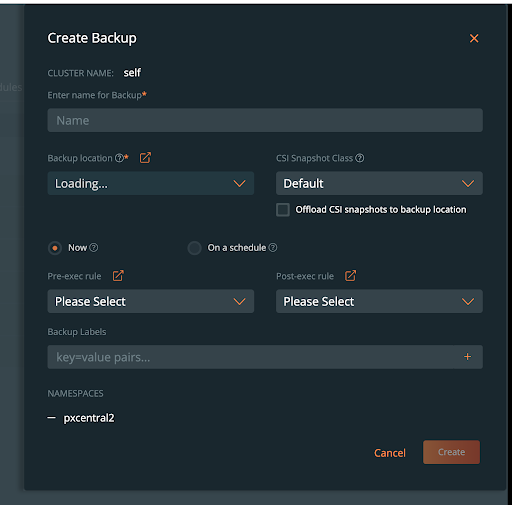
Next, during a restore, PX-Backup will allow you to choose the destination storage type that will restore your persistent volumes back into the desired destination location with a new persistent storage backend.
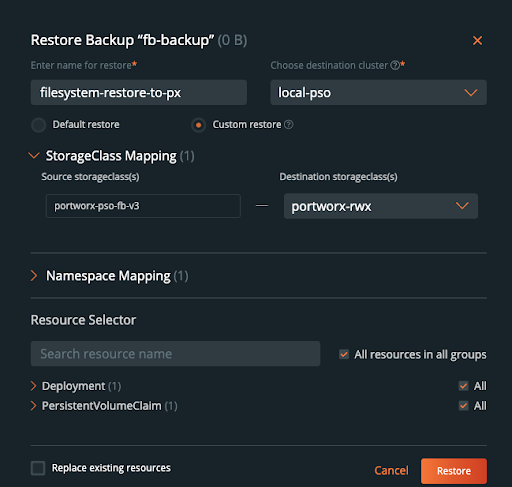
Expanded Recovery with Support for File Shares
PX-Backup has previously used volume snapshots to provide backups of data for applications on Kubernetes using Portworx snapshots or cluster-local CSI snapshots. Using these, PX-backup can provide full and incremental backups at the block volume level. With PX-Backup 2.1, users can also backup at the filesystem level for file systems such as FlashBlade, Portworx proxy volumes, or any NFS server.
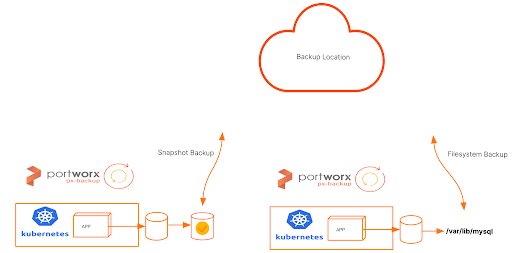
PX-Backup does not need users to change their backup workflows to support this new use case either. To take a filesystem backup of a Pure Storage FlashBlade volume, Portworx proxy volume, or other NFS server-based file shares, simply choose the namespace(s) and resources you are backing up and click “Create” in the backup dialog shown below. PX-Backup will detect the persistent volume storage type and create filesystem-level backups when appropriate.
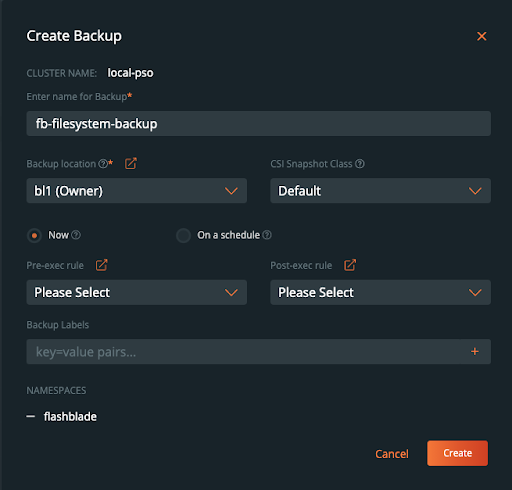
Once you have performed the above steps, your filesystem should now be successfully backed up to your backup location.

Improved Compliance via 3-2-1 Backup Rule Support
The cost of not having data available when you need it can be very expensive. A headline on Forbes.com illustrates how costly it can be: “Facebook Lost About $65 Million During Hours-Long Outage.” By following the “golden rule” of 3-2-1, organizations should have “3” copies of data (a production copy of data, a snapshot copy, and an offsite copy) as well as “2” backups that live on two separate media types (local Kubernetes storage and object storage) and “1” copy that lives in an offsite fault domain for longer-term retention. PX-backup can easily be used to help maintain this golden rule of 3-2-1 for your Kubernetes applications.
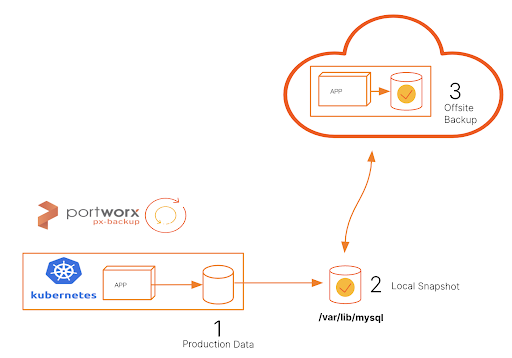
To create a 3-2-1 workflow in PX-Backup, simply take a backup of your namespaces, resources, and PVCs associated with your application. Whether or not you are using Portworx or other CSI compliant backends, PX-backup will take a local snapshot of your data and offload it to the cloud. This will ensure that you keep “3” copies of data (production, snapshot, and offsite), “2” backups that live on two separate media types, and “1” copy that lives offsite in object storage for longer term retention.
Check out PX-Backup 2.1 in action.
Share
Subscribe for Updates
About Us
Portworx is the leader in cloud native storage for containers.
Thanks for subscribing!

Ryan Wallner
Portworx | Technical Marketing ManagerExplore Related Content:
- backup
- disaster recovery
- kubernetes
- portable
- recovery
- restore


